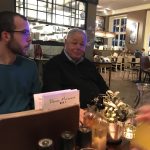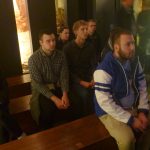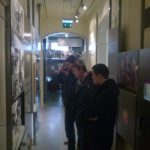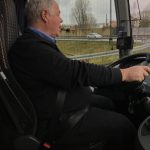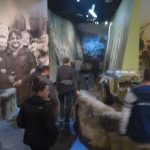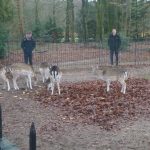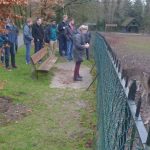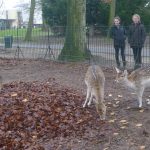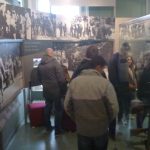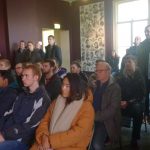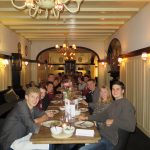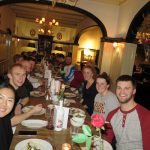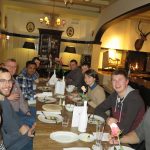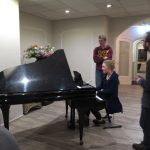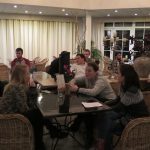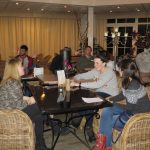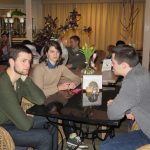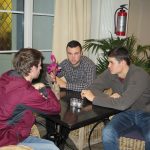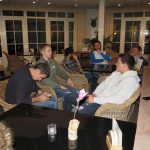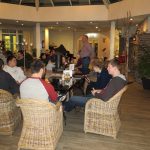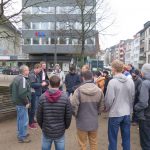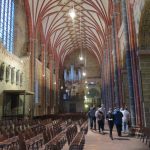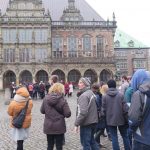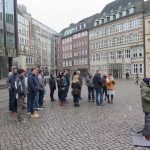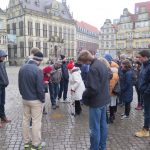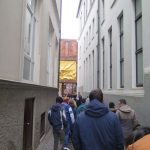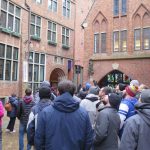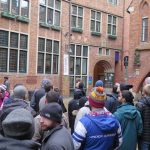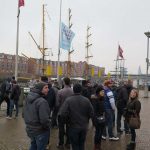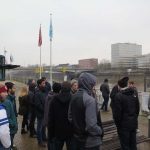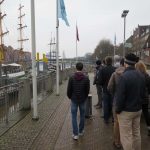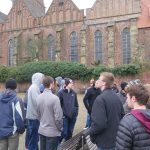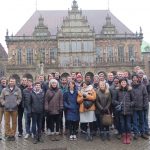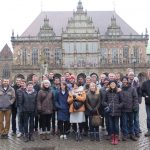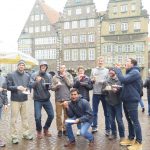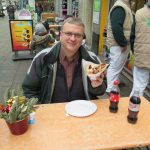I was surprised by the amount of American music we heard through out the places we visited. To be honest, I hadn’t really considered what music French, Dutch, or Germans might listen to, but I never would have guessed it would be mostly American. Continue reading “Music and Globalization”
Free Day in Bremen
There’s no better way to end a trip than spending a relaxing day in a city originating from the 11th century. Bremen, Germany is a city straddling the Weser River in northwestern Germany, and so it originated as a marketplace for maritime trade. More specifically, Bremen was part of the Hanseatic League, a group of cities throughout Europe that allied together to protect each cities economic and diplomatic privileges. These origins could be seen as we spent the day exploring.
We began the day by walking through the Sunday morning marketplace and noted how Europeans purchase food for the next day or two, which is vastly different from many American household. We then walked through the chapel, St. Petri Don, which was originally constructed in the 8th century as a timber cathedral. That cathedral was burnt down, and the now standing cathedral was constructed in the 11th century. The cathedral had beautiful stain glass windows (pictured), and some of us even got to experience a small organ concert later in the day in one of the rooms of the cathedral.

After the cathedral visit, we split off and each explored different parts of the city. We saw things such as the Roland statue, erected in 1404 to protect the city of Bremen. Roland was a paladin for the Holy Roman Empire Charlemagne and is know in legend because of the Battle of Roncevaux Pass, which is ironically Charlemagne’s only military defeat. We also got to witness an interesting clock near the city square, which lasted much longer than we expected. We were also able to view the statue of the Bremen City Musicians, a well known fairy tale about a donkey, dog, cat, and a rooster. It was a beautiful day in an authentic German city.



Zutphen and Operation Market Garden
Zutphen and Operation Market Garden
1/21
It has been a fun trip in Europe! This last full day was spent going back to the Netherlands. Today we learned about Zutphen and got to go the a museum on operation Market Garden.
Zutphen is one of the oldest towns in the Netherlands. It has a church named St. Walburgis which dates back to. The 11th century. The town is also home to one of the five medieval libraries in Europe and it contain very old books and manuscripts still chained to their ancient wooden desks. The town still has many monumental buildings dating back to the 14-15 centuries despite the fact that part of the town was destroyed by WWll.
Operation Market Garden had the objective of securing the bridges across the Rhine for crossing to Germany. The Market was the first airborne division taking control of the bridges. The Garden was the Grand forces attempting the cross the bridges. Unfortunately the operation failed due to the Germans demolishing a bridge before it could be secured. Grand forces where delayed so the Airborne division had to evacuate. This delayed the end of the war. While I was in the museum that was teaching us about this I was most affected by what they had in the basement. It actually gave a bit of sense of what the battle actually looked like and felt like. It was quite grim looking but it was very interesting to experience.
Christopher Pappageorge
Heidlberg
1/15/17 Blog Post
Kolbenz, Heidlberg
In the morning, we had a three hour bus ride ahead of us to go to Kolbenz and Heidlberg. After getting all 29 of us on the bus, everyone closed their eyes right when they sat down in the bus which has been a recurring event every time we get in the bus. Once we got on the highway, I opened up our morning with devotions for today.
Yesterday we went to go to the American Memorial in Luxembourg and Professor Brouwer made a note to the team to be cautious when talking about war while we were in France and Germany. This resonated with me all night and was the focus of my devotion this morning.
I referred to two verses this morning about loving our neighbors as ourselves and that whoever does the will of God, they are our brothers and sisters. I found this verse to be especially relevant to what we have been seeing during our time here. There are two sides to every story and I believe that we are all created in the image of the Father and we are called to love one another. This starting off our morning with this in mind, my prayer was that we would be open to all the people we would encounter.
We drove to our first stop at Deutsches Eck. Driving along the Rhine river was so impressive and all the castles that were built into the mountains. The amount of history and stories that are held in every one of the buildings are probably endless. The colors of every B&B, restaurant and business were so cohesive and quaint. The water levels were so high and this made me realize how big of a problem this could be for the local people.
As we continued throughout our day, our last stop was Heidlberg and it gave me so much context to my church history. I am not Dutch and I was raised in Los Angeles California. It was eye opening to see how the history traveled and made its way to Grand Rapids, MI. I learned a bit more about the Heidlberg Catechism. I also had my very first German dish! I had Schnitzel and Sauerkraut. Because I am Korean, I was used to the pickled cabbage. It was very delicious and very filling!
The market place that we were at had many places to buy chocolates! I feel that on trips like these, there is a lack of fresh veggies and fruits so I also bought myself some strawberries to eat.
Visiting a castle ruin later in the evening was definitely the highlight of my day. Trying my best to fantasize about the stories that the tour guide would tell us helped me visualize what this castle might have looked like during that time. However one of the highlights was the 54,000 gallon wine barrel and a piece of the castle tower that was cut in half because of a bombing from gun powder. Apparently the symbol of this broken tower is that love does not last forever. This romantic message was beautiful because the castle was originally a gift to the princess at the time. This imagery was beautiful to me and made me wonder what I would do if my boyfriend ever bought me a castle haha.
In conclusion, spending the day fantasizing and trying to picture what it would have been like to live during that time was so fun and I came home with a lot of chocolates to give to my friends and family so I would say, it was a successful day.
Janette Ok
Hofbräuhaus
The Hofbräuhaus brewery is located in Munich Germany and was originally built in 1589, it was however not opened to the public until 1828. The building was completely renovated in 1897 when the brewery moved to the suburbs of Munich, however during World War 2 the brewery was destroyed from bombing, all that remained was the historic beer hall. The Hofbräuhaus was then reopened in 1958 to and has been open to the public ever since.
The Hofbräuhaus originates from Wilhelm V. duke of Bavaria, he found the beer in Munich so bad that he imported beer from Saxony. Wilhelm eventually asked his royal court to find a solution and thus they built their own brewery in Munich.
Other then Oktoberfest the Hofbräuhaus is Munich’s largest attraction. As a whole we were lucky enough to have dinner there. The meal we had consisted of pretzels, bread with cheese dips, two types of pork, potato balls, and mixed berries on top whipped creme for dessert.
The Hofbräuhaus has stein lockers for the local members, they are able to leave their steins in their locked locker until they next return for drinks. The Hofbräuhaus also has assigned tables for these members, the only way you’re able to sit at the members table is to be invited to the table by the members.

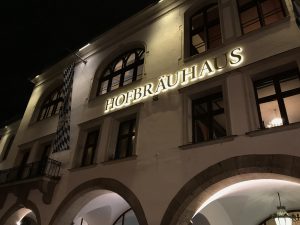
Back to the Netherlands
Today, we left Bremen, Germany and headed to the Netherlands. Our first stop was for lunch at the city of Arnhem. The city has a nice downtown area that has plenty of restaurants and stores. This was the last chance for students to do any shopping before returning to the airport.
After lunch, the group drove to the Operation Market-Garden Museum which is very close to Arnhem. Operation Market-Garden was an allied offensive operation in WWII with the goal of re-taking some key bridges across the Rhine River. Doing so would give the allies an easy way to move equipment into Germany itself. The bridge they wanted was the main bridge of the city of Arnhem. It was a significant battle, but in the end, the operation failed to hold the bridge. Many were lost or taken prisoner during the battle. The basement of the museum tried to recreate the conditions the soldiers experienced in the battle.
After the museum, we headed to the town of Nuspeet for our final night in Europe. After dinner and class discussion, students had time to swim in the pool and hang out for one last evening.
My time in Dachau
The main thing the group did today was go to the concentration camp, Dachau. Some of the feelings I experienced were expected, others not. I expected to feel heartache for what had happened to the people imprison, I did not expect to feel as angry as I did. I expected to feel relieved that the horrible things done by the Nazis are over, I did not expect to feel like humanity hasn’t come very far.
Not to downplay the autrocities done by the Nazi regime, but I started wondering why Western society seems to ignore the other terrible things humans have done to each other, not just in the past but in the present day. I think we often would like to believe that *our* family would be one of the families to hide Jewish people, but at the same time we ignore the needy in our own city. Oftentimes for me it circles around to slavery; many people don’t think human trafficking is a big problem, or if they do they assume it’s an “over there” type of problem that they cannot do anything about. The fact is that in our country, in our state, even in Grand Rapids, tragedies like sex trafficking occur regularly.
I think to truly have a changed heart by seeing what the Jewish people went through in the Nazi Holocaust, we cannot look past the injustices when they happen right in front of us. I’m not sure how, but I truly believe this is a call for me to try to do something to change the world I’m in, even if it’s only in a small way.
Phew, We’re Almost There
Oh boy. Do you ever get tired – like really tired. The type of tired that doesn’t go away after getting a good night of sleep. That’s the kind of tired I am. That being said, I can chalk this exhaustion up to one thing: fun. This trip across Western Europe has been anything but unenjoyable, but I can only hang out with the Dutch locals in their pubs for so long, ya’ know? 😉
In all seriousness, I am beyond thankful for the opportunity I was given to visit such beautiful countries and beautiful peoples. In our visit to the Dacha, I was humbled. Growing up, American children learn a great deal about the Holocaust, but it always seems so far away. I’m only 22 years old, so WWII might as well have been a thousand years ago. But it wasn’t. Concentration camp survivors still live to tell their horrifying past.
Walking through the uninviting camp through equally inviting weather gives one a meager fragment of what life there may have been like for some, and even that was too much for me. Me in my warm puffy coat, wool socks, and longjohns. It wasn’t until I looked at the camp’s creamatorium that I realized how close I was to this tragedy. It wasn’t the ovens themselves, but the ash. The ashes of thousands of innocent people coating the insides of these ovens. In that moment I found myself utterly humbled, questions without answers forming in my head. As I go forward I suspect some may be answered and others not.
As our trip winds down to its inevitable end, I can say with the utmost honesty that I have seen more cathedrals than I hoped, walked more kilometers than I hoped, learned more than I hoped, and grew closer with God and many of my wonderful classmates more than I hoped.
The Fearless Bus Driver
Bold. Daring. Informative.
These words all describe the greatest tour guide and bus driver who ever lived. Born in the Netherlands, Joop (pronounced like “hope” but with a Y) grew up driving a backhoe to install pipe. After ten years he took this precision driving and became a bus driver. Joop has been leading tours all over Europe for 35 years, and has been working with Calvin for 21 of those. He speaks at least 4 languages fluently and knows the best local food stands. When he’s not home with his wife, he likes to build elaborate remote controlled model trucks. He loves listening to 70s and 80s American music, and travels to the USA once a year. He has been to 33 states, and lately enjoys the warm weather in Florida. He introduces us to every city we visit and fills us in on the local history and legends. He is a joyful soul and waves at every tour bus he passes. However, he is not afraid to squeeze though narrow side streets with only an inch of clearance on each side, or cut across 5 lanes of traffic in the Arc de Triomphe circle. In to these capable hands, we entrust our lives.
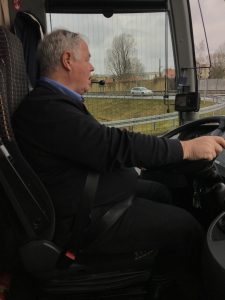
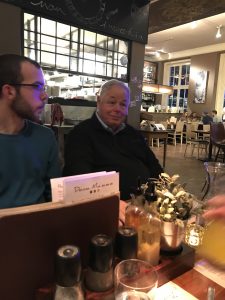
A Day in Bremen
We have been going at a hectic pace for the past two weeks. Today was a chance to have a breather and really explore a city. The city of Bremen has a lot of history, amazing architecture, and a lot of shopping, all within walking distance. The students (and profs) got to sleep in a bit today. We met in the hotel lobby around 10:30am and went for a walk to see some of the city in the daylight as it was dark when we were walking around last night. There was a farmer’s market in a couple of the city squares that was nice to walk around. We were able to walk through St. Petri Dom, one of the catholic churches in the center of the town. After our short walking tour, the students were on their own for lunch and the rest of the day.

